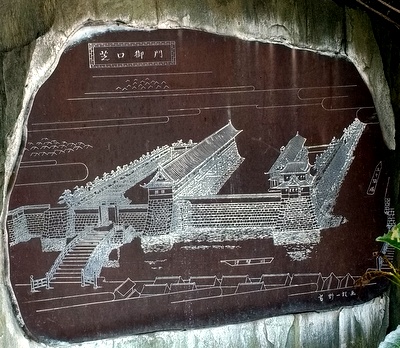The Shibaguchi Gate was a large and ornate gate constructed in the Shiba neighborhood of Edo in 1710 at the suggestion of shogunal advisor Arai Hakuseki. It was later lost in a fire and was never rebuilt.
Not just a simple wooden gate, the Shibaguchi-gomon was an extensive masugata castle gate structure. It sat immediately at the northern end of the bridge at Shinbashi (which was renamed Shibaguchi-bashi, or Shibaguchi Bridge, at that time); crossing the bridge, one would enter a kabukimon style gate, and then turn right, watched from a watari-yagura guardtower and surrounded by high stone walls.
The gate's construction was accompanied by the reconstruction of the Naka-no-gomon, the chief southern gate into the Honmaru (central bailey) of Edo castle. Hakuseki believed that in accordance with Confucian philosophy and Chinese practice, the shogunal city and castle should have particularly impressive gates leading towards and into the castle from the south.[1]
After Hakuseki fell from power around 1716, however, the governing philosophy of the shogunate returned to that of the Hayashi clan, and numerous changes that Hakuseki made to shogunal ritual and ceremony were reversed. The Naka-no-gomon was torn down, and when the Shibaguchi Gate was lost in a fire in 1724/1, no efforts were made to rebuild it.
References
- Watanabe Hiroshi, A History of Japanese Political Thought, 1600-1901, International House of Japan (2012), 148.
- Watanabe Hiroshi 渡辺浩, “’Rei’ ‘Gobui’ ‘Miyabi’ – Tokugawa Seiken no girei to jugaku” 「『礼』『御武威』『雅び』-徳川政権の儀礼と儒学-」, in Kokusai kenkyû shûkai hôkokusho 国際研究集会報告書 vol 22, "Kuge to buke - sono hikaku bunmeishi-teki kenkyû" 公家と武家――その比較文明史的研究――, Kokusai Nihon Bunka Kenkyû Center 国際日本文化研究センター (2004), 171-172.
- Plaque at former site of Shibaguchi Gate.
- ↑ This practice can be seen in the Wumen, Tiananmen, and Zhengyang-men of the Forbidden City in Beijing, and the Namdaemun in Seoul.
External Links
- Former site of the Shibaguchi Gate on Google Maps, at Tokyo, Chūō-ku, Ginza 8-10-8.
